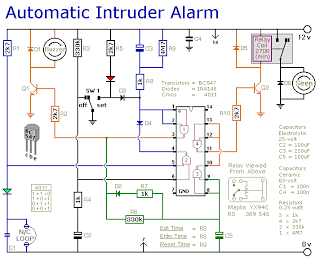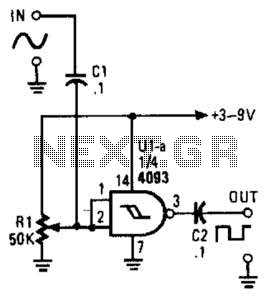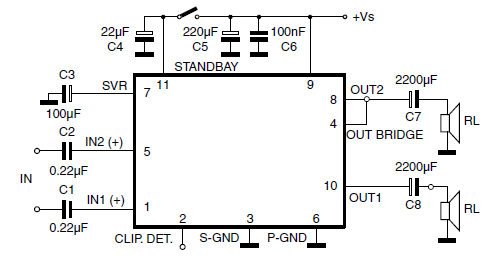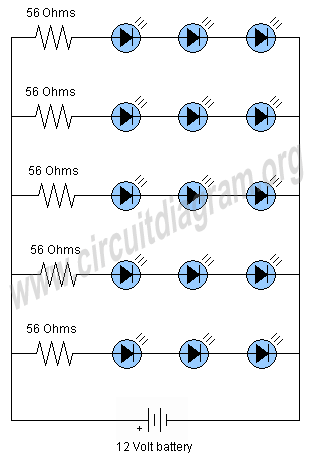
Simple Burglar Alarm circuit

This is a simple single-zone burglar alarm circuit. Its features include automatic exit and entry delays and a timed bell/siren cut-off. It is designed to be used with the usual types of normally-closed input devices such as magnetic reed contacts, micro switches, foil tape, and PIRs. However, it can be easily modified to accept normally-open triggering devices, such as pressure mats. The operation is straightforward. First, ensure that the building is secure and that the green LED is lit. Then, move SW1 to the "set" position, which will illuminate the red LED. This action provides approximately 30 seconds to exit the building. Upon returning and opening the door, the buzzer will sound, allowing another 30 seconds to move SW1 to the "off" position. Failure to do so will energize the relay, causing the siren to sound. The siren will continue to sound while at least one of the switches in the normally-closed loop remains open. Approximately 15 minutes after the loop has been restored, the relay will de-energize, the siren will cut off, and the alarm will reset. The siren can be turned off at any time by moving SW1 to the "off" position. Due to manufacturing tolerances, the precise length of any delay depends on the characteristics of the actual components used in the circuit. However, by altering the values of R3, R6, and R9, the exit, entry, and bell cut-off times can be adjusted to meet specific requirements. Increasing the resistor values will increase the time, and vice versa.
The single-zone burglar alarm circuit is constructed using a combination of resistors, capacitors, diodes, and operational amplifiers to create a reliable and efficient security system. The circuit typically includes a power supply that provides the necessary voltage for operation, usually in the range of 9V to 12V DC. The input devices, such as magnetic reed contacts or PIR sensors, are connected to the circuit in a normally-closed configuration. This ensures that any unauthorized opening of doors or windows will trigger the alarm.
The control switch SW1 is a crucial component that allows users to set or deactivate the alarm. When SW1 is moved to the "set" position, it engages the timing circuit, which is responsible for the exit delay. The red LED serves as an indicator that the alarm is armed, while the green LED indicates that the system is ready for operation.
The timing mechanism is typically implemented using a resistor-capacitor (RC) network, where R3, R6, and R9 are strategically chosen to define the timing intervals. The use of a relay in the circuit allows for the control of the siren and other output devices, ensuring that the alarm can sound loudly enough to deter intruders.
The design also incorporates a feedback mechanism that monitors the state of the input devices. If the circuit detects that a door or window has been opened after the exit delay has expired, the buzzer activates, providing a secondary alert before the siren is engaged.
The siren's cut-off feature is an important safety measure, preventing continuous alarm sound in the event of a false trigger or if the system is inadvertently left in an alarm state. The ability to adjust the timing of the exit, entry, and siren cut-off enhances the flexibility of the system, allowing it to be tailored to different environments and user preferences.
Overall, this burglar alarm circuit provides a simple yet effective solution for securing a single zone, with the potential for customization to accommodate various triggering devices and timing requirements.This is a simple single-zone burglar alarm circuit. Its features include automatic Exit and Entry delays and a timed Bell/Siren Cut-Off. It`s designed to be used with the usual types of normally-closed input devices such as - magnetic reed contacts - micro switches - foil tape - and PIRs. But it can be Easily Modified to accept normally-open trigg ering devices - such as pressure mats. It`s easy to use. First check that the building is secure and that the green LED is lit. Then move SW1 to the "set" position. The red LED will light. You now have about 30 seconds to leave the building. When you return and open the door - the Buzzer will sound. You then have about 30 seconds to move SW1 to the "off" position. If you fail to do so - the relay will energize and the Siren will sound. While at least one of the switches in the normally-closed loop remains open - the Siren will continue to sound. However, about 15-minutes after the loop has been restored - the relay will de-energize - the Siren will Cut-Off - and the alarm will Reset.
Of course, you can turn the Siren off at any time by moving SW1 to the "off" position. Because of manufacturing tolerances - the precise length of any delay depends on the characteristics of the actual components you`ve used in your circuit. But by altering the values of R3, R6 & R9 you can adjust the Exit, Entry and Bell Cut-Off times to suit your requirements.
Increasing the values increases the time - and vice-versa. 🔗 External reference
The single-zone burglar alarm circuit is constructed using a combination of resistors, capacitors, diodes, and operational amplifiers to create a reliable and efficient security system. The circuit typically includes a power supply that provides the necessary voltage for operation, usually in the range of 9V to 12V DC. The input devices, such as magnetic reed contacts or PIR sensors, are connected to the circuit in a normally-closed configuration. This ensures that any unauthorized opening of doors or windows will trigger the alarm.
The control switch SW1 is a crucial component that allows users to set or deactivate the alarm. When SW1 is moved to the "set" position, it engages the timing circuit, which is responsible for the exit delay. The red LED serves as an indicator that the alarm is armed, while the green LED indicates that the system is ready for operation.
The timing mechanism is typically implemented using a resistor-capacitor (RC) network, where R3, R6, and R9 are strategically chosen to define the timing intervals. The use of a relay in the circuit allows for the control of the siren and other output devices, ensuring that the alarm can sound loudly enough to deter intruders.
The design also incorporates a feedback mechanism that monitors the state of the input devices. If the circuit detects that a door or window has been opened after the exit delay has expired, the buzzer activates, providing a secondary alert before the siren is engaged.
The siren's cut-off feature is an important safety measure, preventing continuous alarm sound in the event of a false trigger or if the system is inadvertently left in an alarm state. The ability to adjust the timing of the exit, entry, and siren cut-off enhances the flexibility of the system, allowing it to be tailored to different environments and user preferences.
Overall, this burglar alarm circuit provides a simple yet effective solution for securing a single zone, with the potential for customization to accommodate various triggering devices and timing requirements.This is a simple single-zone burglar alarm circuit. Its features include automatic Exit and Entry delays and a timed Bell/Siren Cut-Off. It`s designed to be used with the usual types of normally-closed input devices such as - magnetic reed contacts - micro switches - foil tape - and PIRs. But it can be Easily Modified to accept normally-open trigg ering devices - such as pressure mats. It`s easy to use. First check that the building is secure and that the green LED is lit. Then move SW1 to the "set" position. The red LED will light. You now have about 30 seconds to leave the building. When you return and open the door - the Buzzer will sound. You then have about 30 seconds to move SW1 to the "off" position. If you fail to do so - the relay will energize and the Siren will sound. While at least one of the switches in the normally-closed loop remains open - the Siren will continue to sound. However, about 15-minutes after the loop has been restored - the relay will de-energize - the Siren will Cut-Off - and the alarm will Reset.
Of course, you can turn the Siren off at any time by moving SW1 to the "off" position. Because of manufacturing tolerances - the precise length of any delay depends on the characteristics of the actual components you`ve used in your circuit. But by altering the values of R3, R6 & R9 you can adjust the Exit, Entry and Bell Cut-Off times to suit your requirements.
Increasing the values increases the time - and vice-versa. 🔗 External reference





